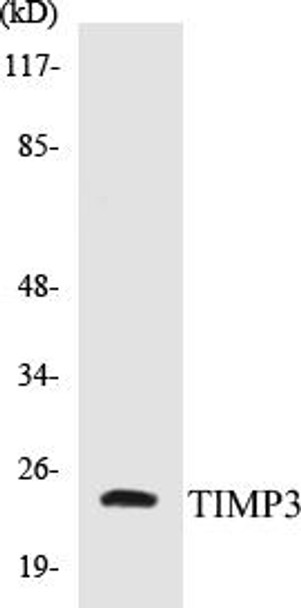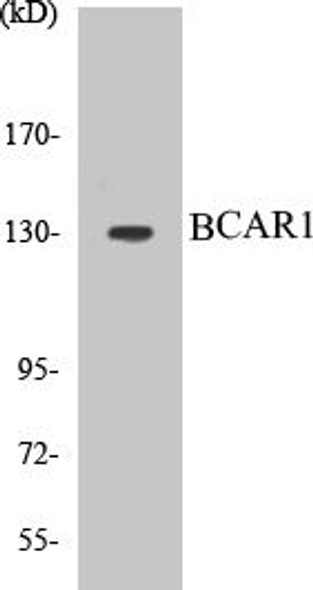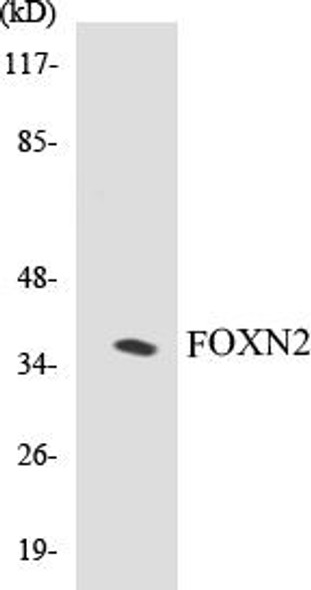TIMP3 Colorimetric Cell-Based ELISA Kit (CBCAB00369)
- SKU:
- CBCAB00369
- Product Type:
- ELISA Kit
- ELISA Type:
- Cell Based
- Research Area:
- Signal Transduction
- Reactivity:
- Human
- Mouse
- Rat
- Detection Method:
- Colorimetric
Description
TIMP3 Colorimetric Cell-Based ELISA Kit
The TIMP3 Colorimetric Cell-Based ELISA Kit by Assay Genie is specifically designed for the accurate detection of Tissue Inhibitor of Metalloproteinase 3 (TIMP3) levels in various biological samples. This kit offers high sensitivity and specificity, ensuring precise and reliable results for researchers in a wide range of fields.TIMP3 is a crucial protein that plays a key role in regulating the extracellular matrix and inhibiting the activity of matrix metalloproteinases (MMPs), which are involved in tissue remodeling and degradation. Dysregulation of TIMP3 has been linked to various diseases such as cancer, cardiovascular disorders, and inflammatory conditions, making it an important biomarker for understanding these pathological processes.
With the TIMP3 Colorimetric Cell-Based ELISA Kit, researchers can accurately measure TIMP3 levels in cell culture supernatants, serum, and plasma samples, providing valuable insights into the role of TIMP3 in various physiological and pathological processes. This kit is easy to use, highly reliable, and offers excellent reproducibility, making it an essential tool for studying TIMP3 biology and developing potential therapeutic strategies.
| Product Name: | TIMP3 Colorimetric Cell-Based ELISA Kit |
| Product Code: | CBCAB00369 |
| ELISA Type: | Cell-Based |
| Target: | TIMP3 |
| Reactivity: | Human, Mouse, Rat |
| Dynamic Range: | > 5000 Cells |
| Detection Method: | Colorimetric 450 nmStorage/Stability:4°C/6 Months |
| Format: | 96-Well Microplate |
The TIMP3 Colorimetric Cell-Based ELISA Kit is a convenient, lysate-free, high throughput and sensitive assay kit that can detect TIMP3 protein expression profile in cells. The kit can be used for measuring the relative amounts of TIMP3 in cultured cells as well as screening for the effects that various treatments, inhibitors (ie siRNA or chemicals), or activators have on TIMP3.
Qualitative determination of TIMP3 concentration is achieved by an indirect ELISA format. In essence, TIMP3 is captured by TIMP3-specific primary antibodies while the HRP-conjugated secondary antibodies bind the Fc region of the primary antibody. Through this binding, the HRP enzyme conjugated to the secondary antibody can catalyze a colorimetric reaction upon substrate addition. Due to the qualitative nature of the Cell-Based ELISA, multiple normalization methods are needed:
| 1. | A monoclonal antibody specific for human GAPDH is included to serve as an internal positive control in normalizing the target absorbance values. |
| 2. | Following the colorimetric measurement of HRP activity via substrate addition, the Crystal Violet whole-cell staining method may be used to determine cell density. After staining, the results can be analysed by normalizing the absorbance values to cell amounts, by which the plating difference can be adjusted. |
| Database Information: | Gene ID: 7078, UniProt ID: P35625, OMIM: 136900/188826, Unigene: Hs.644633/Hs.714168 |
| Gene Symbol: | TIMP3 |
| Sub Type: | None |
| UniProt Protein Function: | TIMP3: Complexes with metalloproteinases (such as collagenases) and irreversibly inactivates them by binding to their catalytic zinc cofactor. May form part of a tissue-specific acute response to remodeling stimuli. Known to act on MMP-1, MMP-2, MMP-3, MMP-7, MMP-9, MMP-13, MMP-14 and MMP-15. Interacts with EFEMP1. Belongs to the protease inhibitor I35 (TIMP) family. |
| UniProt Protein Details: | Protein type:Motility/polarity/chemotaxis; Secreted; Secreted, signal peptide Chromosomal Location of Human Ortholog: 22q12.3 Cellular Component: extracellular matrix; extracellular space; proteinaceous extracellular matrix; basement membrane; nucleus Molecular Function:metalloendopeptidase inhibitor activity; protein binding; protease binding; metal ion binding Biological Process: negative regulation of metalloenzyme activity; visual perception; response to cytokine stimulus; response to hormone stimulus; negative regulation of membrane protein ectodomain proteolysis Disease: Fundus Dystrophy, Pseudoinflammatory, Of Sorsby |
| NCBI Summary: | This gene belongs to the TIMP gene family. The proteins encoded by this gene family are inhibitors of the matrix metalloproteinases, a group of peptidases involved in degradation of the extracellular matrix (ECM). Expression of this gene is induced in response to mitogenic stimulation and this netrin domain-containing protein is localized to the ECM. Mutations in this gene have been associated with the autosomal dominant disorder Sorsby's fundus dystrophy. [provided by RefSeq, Jul 2008] |
| UniProt Code: | P35625 |
| NCBI GenInfo Identifier: | 730948 |
| NCBI Gene ID: | 7078 |
| NCBI Accession: | P35625.2 |
| UniProt Secondary Accession: | P35625,Q5THV4, Q9UC74, Q9UGS2, B2RBY9, |
| UniProt Related Accession: | P35625 |
| Molecular Weight: | 24,145 Da |
| NCBI Full Name: | Metalloproteinase inhibitor 3 |
| NCBI Synonym Full Names: | TIMP metallopeptidase inhibitor 3 |
| NCBI Official Symbol: | TIMP3 |
| NCBI Official Synonym Symbols: | SFD; K222; K222TA2; HSMRK222 |
| NCBI Protein Information: | metalloproteinase inhibitor 3; TIMP-3; MIG-5 protein; protein MIG-5; tissue inhibitor of metalloproteinases 3 |
| UniProt Protein Name: | Metalloproteinase inhibitor 3 |
| UniProt Synonym Protein Names: | Protein MIG-5; Tissue inhibitor of metalloproteinases 3; TIMP-3 |
| Protein Family: | Metalloproteinase inhibitor |
| UniProt Gene Name: | TIMP3 |
| UniProt Entry Name: | TIMP3_HUMAN |
| Component | Quantity |
| 96-Well Cell Culture Clear-Bottom Microplate | 2 plates |
| 10X TBS | 24 mL |
| Quenching Buffer | 24 mL |
| Blocking Buffer | 50 mL |
| 15X Wash Buffer | 50 mL |
| Primary Antibody Diluent | 12 mL |
| 100x Anti-Phospho Target Antibody | 60 µL |
| 100x Anti-Target Antibody | 60 µL |
| Anti-GAPDH Antibody | 60 µL |
| HRP-Conjugated Anti-Rabbit IgG Antibody | 12 mL |
| HRP-Conjugated Anti-Mouse IgG Antibody | 12 mL |
| SDS Solution | 12 mL |
| Stop Solution | 24 mL |
| Ready-to-Use Substrate | 12 mL |
| Crystal Violet Solution | 12 mL |
| Adhesive Plate Seals | 2 seals |
The following materials and/or equipment are NOT provided in this kit but are necessary to successfully conduct the experiment:
- Microplate reader able to measure absorbance at 450 nm and/or 595 nm for Crystal Violet Cell Staining (Optional)
- Micropipettes with capability of measuring volumes ranging from 1 µL to 1 ml
- 37% formaldehyde (Sigma Cat# F-8775) or formaldehyde from other sources
- Squirt bottle, manifold dispenser, multichannel pipette reservoir or automated microplate washer
- Graph paper or computer software capable of generating or displaying logarithmic functions
- Absorbent papers or vacuum aspirator
- Test tubes or microfuge tubes capable of storing ≥1 ml
- Poly-L-Lysine (Sigma Cat# P4832 for suspension cells)
- Orbital shaker (optional)
- Deionized or sterile water
*Note: Protocols are specific to each batch/lot. For the correct instructions please follow the protocol included in your kit.
| Step | Procedure |
| 1. | Seed 200 µL of 20,000 adherent cells in culture medium in each well of a 96-well plate. The plates included in the kit are sterile and treated for cell culture. For suspension cells and loosely attached cells, coat the plates with 100 µL of 10 µg/ml Poly-L-Lysine (not included) to each well of a 96-well plate for 30 minutes at 37°C prior to adding cells. |
| 2. | Incubate the cells for overnight at 37°C, 5% CO2. |
| 3. | Treat the cells as desired. |
| 4. | Remove the cell culture medium and rinse with 200 µL of 1x TBS, twice. |
| 5. | Fix the cells by incubating with 100 µL of Fixing Solution for 20 minutes at room temperature. The 4% formaldehyde is used for adherent cells and 8% formaldehyde is used for suspension cells and loosely attached cells. |
| 6. | Remove the Fixing Solution and wash the plate 3 times with 200 µL 1x Wash Buffer for five minutes each time with gentle shaking on the orbital shaker. The plate can be stored at 4°C for a week. |
| 7. | Add 100 µL of Quenching Buffer and incubate for 20 minutes at room temperature. |
| 8. | Wash the plate 3 times with 1x Wash Buffer for 5 minutes each time. |
| 9. | Add 200 µL of Blocking Buffer and incubate for 1 hour at room temperature. |
| 10. | Wash 3 times with 200 µL of 1x Wash Buffer for 5 minutes each time. |
| 11. | Add 50 µL of 1x primary antibodies (Anti-TIMP3 Antibody and/or Anti-GAPDH Antibody) to the corresponding wells, cover with Parafilm and incubate for 16 hours (overnight) at 4°C. If the target expression is known to be high, incubate for 2 hours at room temperature. |
| 12. | Wash 3 times with 200 µL of 1x Wash Buffer for 5 minutes each time. |
| 13. | Add 50 µL of 1x secondary antibodies (HRP-Conjugated AntiRabbit IgG Antibody or HRP-Conjugated Anti-Mouse IgG Antibody) to corresponding wells and incubate for 1.5 hours at room temperature. |
| 14. | Wash 3 times with 200 µL of 1x Wash Buffer for 5 minutes each time. |
| 15. | Add 50 µL of Ready-to-Use Substrate to each well and incubate for 30 minutes at room temperature in the dark. |
| 16. | Add 50 µL of Stop Solution to each well and read OD at 450 nm immediately using the microplate reader. |
(Additional Crystal Violet staining may be performed if desired – details of this may be found in the kit technical manual.)






